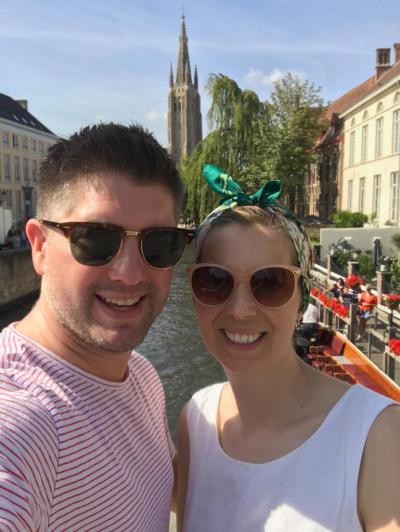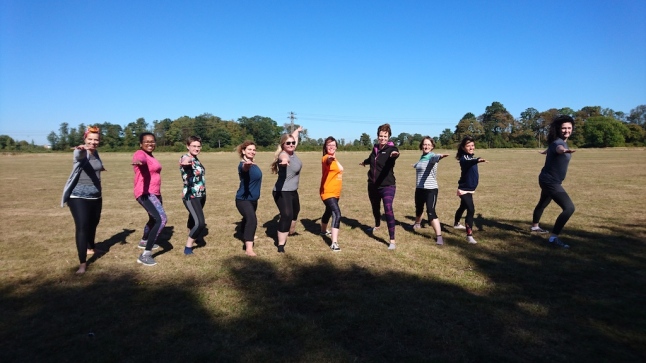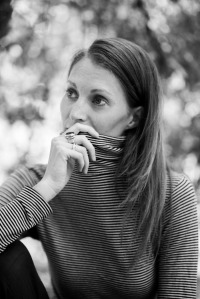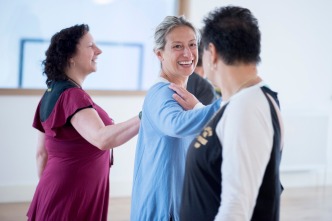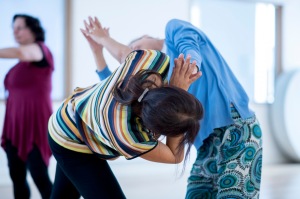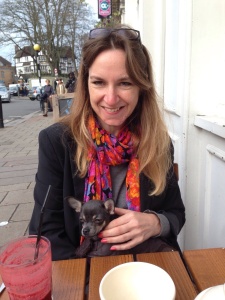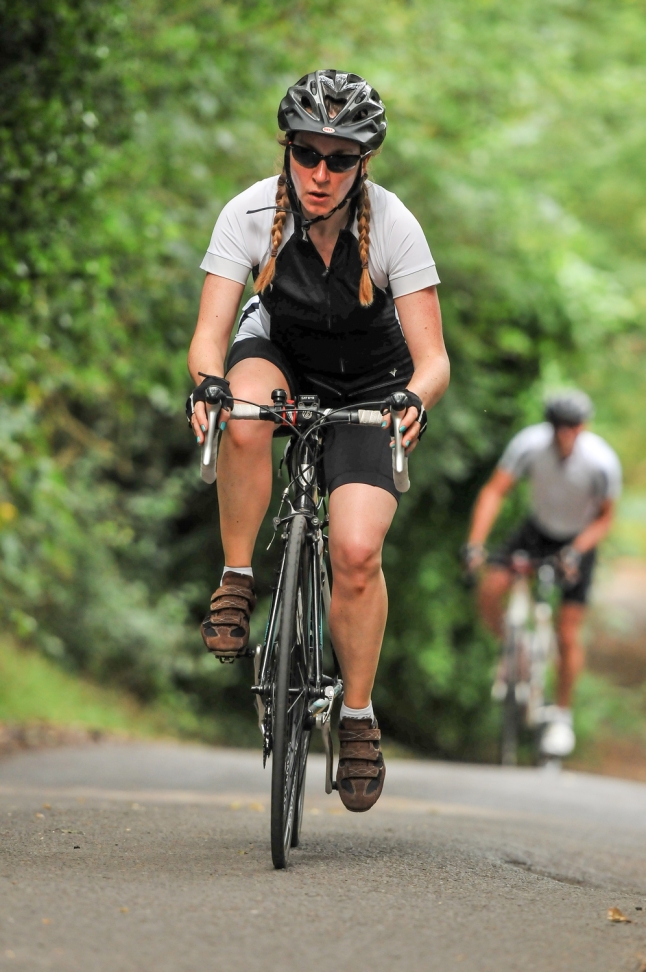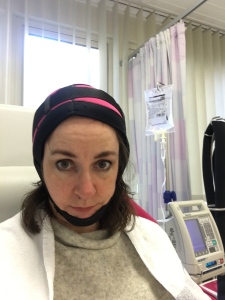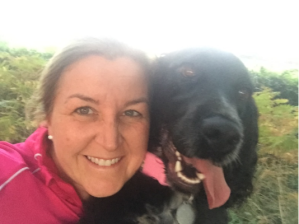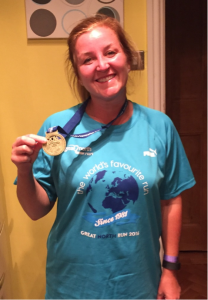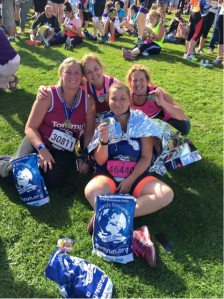Every year, at Shine’s Great Escape, we run morning yoga sessions for our “Escapees”. For many, it’s the first time they’ve tried yoga and most people are pleasantly surprised by how much they get out of it.
In this blog, Stephanie Bartlett shares her experience of starting yoga during her cancer treatment and how it’s helped calm her busy mind. Want to learn more? Below Stephanie’s blog, we’ve posted some ‘getting started’ tips from Shine’s yoga guru (and podcast host) Tatum de Roeck!
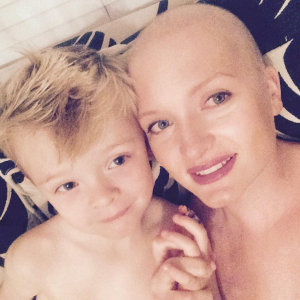
Stephanie with son Theo
Last July I was diagnosed with cancer. As a young and healthy 32 year old, I certainly wasn’t expecting it, though I have learnt very quickly it genuinely doesn’t matter who you are or how ‘healthy’ you thought you were.
Cancer for me has been ‘mind consuming’. In the seven months since my diagnosis, my mind has been consumed with everything cancer related, from the seemingly endless weeks of waiting for test results to the side effects of 18 weeks of chemotherapy to the apprehension of the next course of treatment; there was just no getting away from it.
That was until I discovered yoga. My very first yoga session consisted of some simple breathing techniques and some basic stretching and relaxation. I followed my instructor and it was very peaceful. I found it easy and I soon realised that an hour had passed and I hadn’t thought about cancer.
I can only describe how I felt after my first session as a balloon floating in the sea. I felt present in the here and now. My mind felt completely empty. No thoughts had entered my mind the entire time. I had no idea what it felt like to be free of the constant cancer woes until then. I also felt very relaxed, like a weight had been lifted off my shoulders and like I was finally lightened of the burden.
I continued to practice yoga with my instructor about once a fortnight and before I knew it I had learned a whole yoga flow and every session we were adding to it. I was also learning more how good it was for my mind and body. Post-surgery and during chemotherapy I looked forward to each session as I viewed it as my escape from cancer. I then found myself doing yoga on my own at home in the days in between seeing my instructor – I could finally escape cancer every day. I knew exactly what to do and I loved it.
The truly great thing about yoga is that no matter how I was feeling or how physically able I was (and this changed from week to week, with the effects of surgery or chemotherapy), I was always able to do yoga. And it’s really not about getting one leg wrapped around your neck while balancing in the shape of an elegant swan – rather, it’s all about connecting with yourself and using your mind and body no matter how much you’re able to move. Basically, we can all do it, no matter how flexible you are.
As a busy and working mum to my five-year-old son, Theo, I’m constantly on the go. Life is always eventful and there’s no escaping the constant need to be somewhere or do something. This consumed a lot of my thoughts before cancer and adding cancer to that mix made life even crazier. Yoga enabled me not only to calm down my mind but also to focus on simply moving and breathing. It lets me forget the chaos that life has thrown at me and it enables me to put into perspective the important things that are worthy of my attention. Most importantly, it also helps me forget about the pointless little things that can fill the gaps.
I have certainly caught the yoga bug; I now know a moon flow, what sun salutation is and can do my warrior poses. During each of these yoga flows, the actions and breathing are the only things on my mind. Even before the cancer diagnosis I didn’t know it was possible to escape; I’ve always had a busy mind so for me it’s been a real eye opener. 
I cannot recommend yoga enough to anyone going through a cancer diagnosis or treatment – an even those that aren’t. I once thought “oh, yoga is not for me – it’s too airy fairy”. How wrong I was! I have even booked myself onto a four day yoga retreat in Spain, as a reward once all my treatment is over. It’ll involve hours of yoga, relaxation and a well needed break in the sun.I genuinely never believed yoga would help me as much as it does but I honestly love what yoga does for me. Give it a go, you won’t know until you try it!
Stephanie lives with her son, Theo, who is five, and she was one of Shine’s 2017 Escapees. To learn more about the Great Escape, click here. And if you’re interested in trying yoga, read on for a briefing by our yoga instructor (and podcast host) Tatum de Roeck!
Thinking of trying yoga after cancer?
Three months after Tatum de Roeck qualified as a yoga teacher, she was diagnosed with breast cancer. Below, she shares her tips for getting started with yoga. 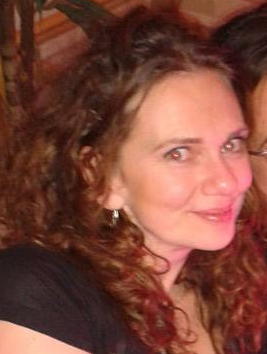
Even knowing quite a bit about yoga, I was still daunted going into a new class when my body felt so alien. It was tough dealing with feeling physically limited, emotionally all over map and mentally frazzled. What made it easier was having an idea what to expect from a class and how to find the right one.
I now teach yoga as my main job and give classes as part of Shine’s Great Escape weekend. Many Escapees have never done yoga before and the class has given them the chance to find out they rather like it! So for others who think they might fancy giving yoga a whirl here are some tips and thoughts to help make finding the first class a little easier.
Yoga is yoga, right?
Not all yoga is the same. The spectrum of classes range from ones where all the poses involve lying down on the ground with cushions and blocks, to hot sweaty powerful classes that seem to be created for acrobats from Cirque du Soliel.
I’m not flexible, can I still do yoga?
Yes! Yoga isn’t about what it looks like on the outside but how it feels inside your body. You can be one millimetre into a pose and feel the benefit of the stretch. If you feel it, that’s your pose and it is perfect. Someone else might have a different rotation in their hip joint and their legs may impressively flop out, but they may be working on how to engage their muscles instead which might be just as much of a challenge. It’s good to bear in mind since everyone’s body is wildly different (and always changing) we don’t bend to yoga, it is yoga that should bend to us.
Starting Slow
Slow classes give you time to try a pose, see if it’s right for you and adjust as needed. Even if it’s a super relaxing class it gives you a chance to hear some yoga terminology, become familiar with teachers providing different options, and to build confidence for trying the next class.
How do I find a slow class?
If there is a yoga studio nearby I would either pop in or give them a call to ask if they offer a relaxing, slow or gentle classes. Some bigger studios sometimes even offer classes handily named something like ‘yoga for people with cancer’. Most mid-size studios will have great introductory offers of unlimited classes for a couple of weeks. This can be a really useful (and far cheaper) way to try out different classes. Sometimes yoga classes at the gym are unhelpfully labelled ‘yoga’. In these cases its useful to get some more info otherwise you might be in a sweaty power hour territory.
The key things to ask is it is suitable for beginners and is it gentle? If possible it may be good to see if you can briefly contact the teacher before you plan to take the class.
A lot of cancer centres like Maggie’s also offer yoga and if they don’t offer yoga on the premises it’s worth giving them a call to see if they know a place or a teacher they’d recommend.
What do I wear?
The main thing is to wear something comfortable, which doesn’t restrict movement but isn’t too loose. The reason we don’t wear baggy T-shirts is because some of the poses (like a forward fold or child’s pose) will cause loose T-shirts to ride up exposing the stomach and lower back or rising so much it covers your face. Very baggy shorts can also show a bit more than you bargained for. If this happens you spend the class fighting with your clothes which takes away a little of the joy (I’m relaying this from personal experience!).
Getting to the first class early
It’s a good idea to get to your first class 15 minutes early. There will be forms to fill out and it’s a good time to talk to the teacher before the class starts. You can let them know you are trying yoga for the first time, that you may need to take it easy or have a part of your body where there is a limitation of movement. They are the best people to give you a bit of an idea about what to expect in the class.
Do I need to do all the poses?
Nope! Yoga is about being in the body and feeling out what is right for you. Anything that causes sharp pinching pain or any sensation which takes your breath away is a sign from your body saying that position isn’t right for you at that time. If this happens you can come out of the pose slightly or fully. There is a pose called child’s pose which is the go to position any time in the practice. It’s the pose to regain your breath, to rest or simply stay there until another pose that you might like comes along.
Giving it another go
Since there is such a variety in yoga styles, teacher personalities and range of environments it is worth giving yoga more than one class to really determine whether or not it’s right for you. If you find it ultimately isn’t what you want at the moment that’s totally ok too! You’ll know what it is and that it’s there if you ever want to come back to it.
Ask for Recommendations
One of the best ways to find a class is to ask others who have tried and tested classes already. In the comments below, feel free to share your experiences and any places or teachers you love. You never know another Shiny person may be in your ‘hood and looking for a class!
